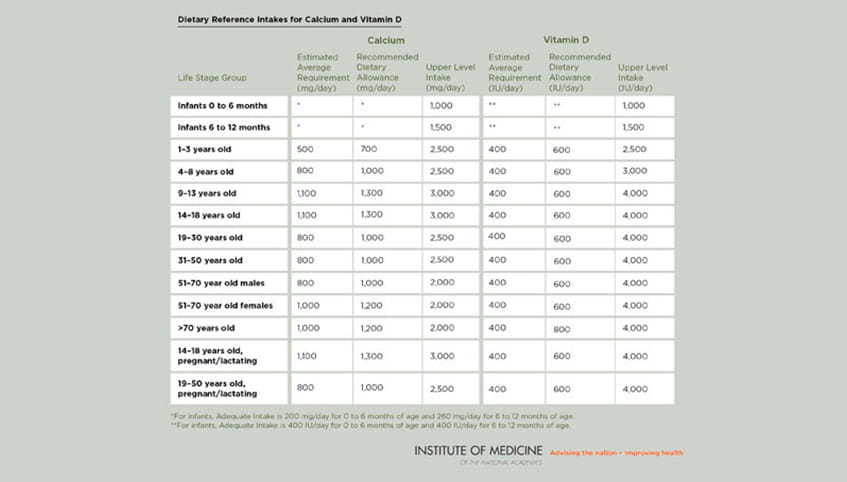Vitamin D is a steroid and a hormone. It helps our bodies maintain healthy bones, absorb calcium, ward off disease and strengthen our immune system. If you’re an athlete, having the right amount of vitamin D can improve your balance and timing and make you faster and stronger. Evidence-based research shows we can improve our health and enhance performance if we have enough vitamin D. We also need to consume adequate calcium for proper absorption and utilization. The National Institutes of Health reports that the 25-hydroxy vitamin D test is the most accurate measuring tool for determining whether you have enough vitamin D in your system. Talk to your doctor to learn more about your vitamin D requirements.

Benefits of vitamin D:
- Fights off infections
- Helps prevent flu
- Helps prevent cancer
- Strengthens bones and muscles
- Reduces fractures
- Helps heal wounds
How much vitamin D do I need?
The amount of vitamin D you need varies. Typically, children age 9 and older need up to 4,000 units per day.
How do I know if I need vitamin D supplementation?
The only way to know for certain if you need vitamin D supplements is to take a blood test, which your physician can provide. Other considerations include foods you eat and drink and the amount of sunshine you are exposed to.
What is a normal vitamin D level?
According to the Institute of Medicine, the optimum range of 25-hydroxy vitamin D in the blood is 20-50 nanograms per milliliter, abbreviated ng/mL.
Your physician can check your 25 (OH) level. Once you know your level, you and your doctor can determine if you need to take supplements.
Vitamin D comes from:
- Sunshine, specifically UVB light
- Foods and beverages
- Supplementation of vitamin D2 or D3
According to the Vitamin D Council, a single, 30-minute dose of sunshine can potentially stimulate the production of up to 10,000 IU of vitamin D. It is highly unlikely that doses below 10,000 IU will cause harm.
Where does calcium come into play?
Calcium is a mineral. Calcium recommendations are closely intertwined with vitamin D because they work together. A general recommendation is 500-3,000 milligrams daily of calcium. See table for specific guidelines. The body doesn’t absorb calcium doses above 500 milligrams as well as smaller doses. If you’re taking a large dose of calcium, take it in divided doses.
Discuss the need for calcium supplementation with your physician and dietitian. Consuming adequate calcium from foods and beverages is easier than you think.
Can I eat and drink my vitamin D and calcium?
Dietitians typically advocate real foods and beverages first, then supplements if necessary. There are numerous sources of vitamin D and calcium in addition to milk and dairy products.
Vitamin D is a fat-soluble vitamin that is naturally present in very few foods, added to others, and available as a dietary supplement. The primary dietary sources of vitamin D include vitamin D-fortified milk, orange juice, yogurt, cereals or eggs (yolks). Also, a daily multivitamin may provide 200-400 IU. Check your multivitamin for the amount supplied.
The U.S. Department of Agriculture's Nutrient Database website lists the nutrient content of many foods. It also provides a comprehensive list of foods containing vitamin D.
Check out the amounts of vitamin D and calcium supplied by the foods and beverages you typically consume. If you are not reaching your goal, talk with your doctor and dietitian to come up with a plan for your success.
| Vitamin D per serving | Food |
| 1,350 IU | Cod liver oil, 1 tablespoon |
| 550 IU | Swordfish, cooked, 3 ounces |
| 450 IU | Salmon (sockeye), cooked, 3 ounces |
| 150 IU | Tuna, canned in water, drained, 3 ounces |
| 130 IU | Orange juice fortified with vitamin D, 1 cup |
| 115 - 120 IU | Milk, nonfat, reduced-fat and whole, vitamin-D-fortified, 1 cup |
| 80 IU | Yogurt, fortified with 20% of the DV for vitamin D, 6 ounces |
| 60 IU | Margarine, fortified, 1 tablespoon |
| 45 IU | Sardines, canned in oil, drained, 2 sardines |
| 40 IU | Liver, beef, cooked, 3 ounces |
| 40 IU | Egg, 1 large (vitamin D is found in yolk) |
| 40 IU | Ready-to-eat cereal, fortified in vitamin D, 3/4-1 cup |
| Calcium per serving | Food |
| 300 mg | 1 cup milk (fat-free, low-fat, chocolate and buttermilk) |
| 1 cup nonfat or low-fat yogurt | |
| 1 cup calcium-fortified soy milk or rice milk | |
| 1 cup calcium-fortified orange juice | |
| 1 1/2 ouces low-fat-natural cheese (such as cheddar, mozzarella, or Swiss | |
| 2 ouces processed cheese (such as American) | |
| 1 cup ready-to-eat pudding | |
| 1 cup macaroni and cheese | |
| 200 mg | 3 ounces canned salmon (with soft bones) |
| 3 ounces sardines (with soft bones) | |
| 1 cup calcium-fortified cereal | |
| 1 ounces feta cheese | |
| 150 mg | 1 cup cottage cheese |
| 1/2 cup tofu (made with calcium) | |
| 1 slice calcium-fortified bread | |
| 100 mg | 1/2 cup frozen yogurt or ice cream |
| 1/4 cup almonds | |
| 1/2 cup cooked greens (beet greens, turnip greens, kale, collards, spinach) | |
| 1 English muffin | |
| 1/2 cup soybeans | |
| 50 mg | 1 medium orange |
| 1/2 cup cooked broccoli | |
| 1/2 cup canned white beans | |
| 1 medium baked sweet potato |
Soft drinks may interfere with the absorption of vitamin D and calcium. If you think your game could improve, talk to your doctor and dietitian.
Overview
Guidelines for safe and effective supplementation with vitamin D:
- Find out your 25 (OH) D level.
- If you do not yet know your 25 (OH) D levels, approximately 2,000 units daily is a reasonable dose of vitamin D to take until you can have your levels tested.
- Consume adequate calcium or consider a supplement.

Sports performance for every athlete
We offer adult fitness and sports performance classes, specialized injury prevention classes, sports nutrition consultations and physical therapy.




